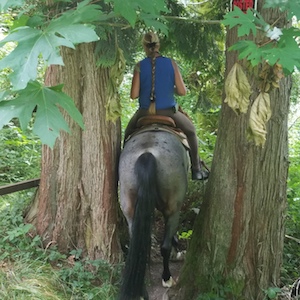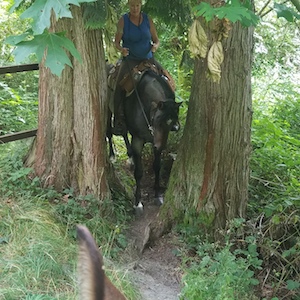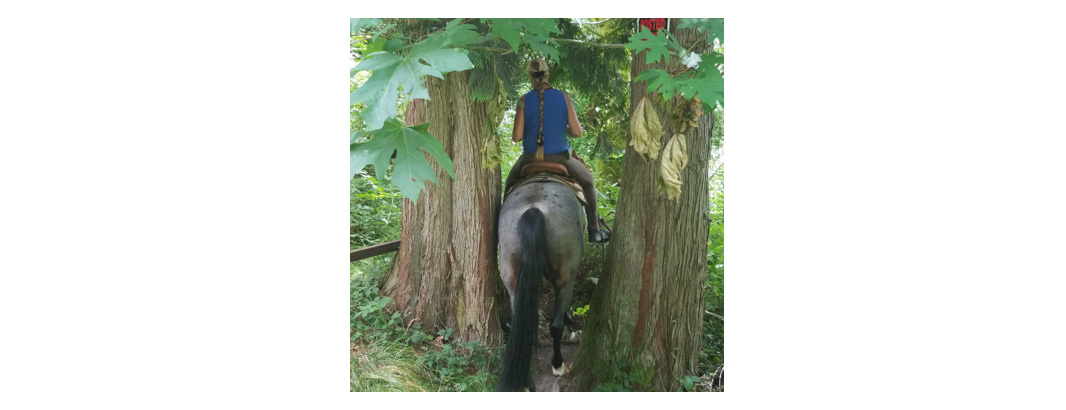Train for Narrow Places on the Trail
by Jill Holdal with Julie Lewis Schot
It’s common to encounter knee-knocking narrow points on the trail. If your horse rams your legs into trees, rushes through tight spots, or simply refuses them, your safety may be at risk. Trainer Jill Holdal employs an exercise she calls Spare My Knees, Please, where she stops a horse between two trees to help him learn to better negotiate tight spots on the trail and improve safety.
How can I prepare my horse for narrow places on the trail?
It’s crucial that your horse has a good foundation before you hit the trail. It all starts at the mounting block. Your horse needs to stand still when mounted, stay quiet, and learn that this is a time to chill out and relax. Once he stands quietly on a loose rein, then it’s time to progress to other areas of the arena or out on the trail.
Rider error is one of the main reasons horses will not stand still when mounted. The horse should never move off until you ask. You’re setting yourself up for trouble on the trail if you allow this. Are you anticipating your horse’s first steps and picking up contact before allowing the horse to relax on a loose rein? Maybe you don’t trust your horse to stand still without rein contact.

How do I get my horse to stand still when being mounted?
You might have to teach him to stand still by making him move. Use one rein lateral flexion and disengage him in circles every time he moves before you ask. Once he stands quietly you can praise him. He will learn that mounting is a time to relax or he will have to work. He will never learn to stand still if you always depart as soon as you’re in the saddle; you are teaching him to walk off right away. This is crucial preparation for the exercises out on the trail.
How do you continue this work on the trail?
All the horses in my training program, even seasoned ones, continue with the work of standing quietly on a loose rein. I stop them often on the trail to make sure they are still focused on me. We’ll stand quietly again with a draped rein. I use it in various locations—up and down hills, under tree branches, at narrow creek crossings and in any tight location we encounter.
Specific to the Spare My Knees, Please exercise, set up barrels, poles or anything you can find to create a tight space at home to practice. It’s easier if you start with a wider distance between two obstacles and squeeze down from there so the horse becomes progressively more comfortable. On the trail, you can then practice between wider trees before taking them through trees as tight as in the photos. This is a very tight squeeze followed by a hairpin turn, so it is not a starting point in training.
What should a rider do as she approaches a tight spot on the trail?
As you approach a tight spot or obstacle don’t tense up; don’t take extra contact on the face and don’t think about what could go wrong. Relax. I like to stop the horse halfway through and let him rest. Again, you want that loose rein while you let your horse stand. You want your horse to relax. You want to teach him there is no need to rush through when he may be uncomfortable.

Some horses may refuse; ask them for baby steps instead. Just get their nose or face between the trees, then back up a step or two. Then get the shoulders in, then back up, and so on. Don’t be in a hurry. In the photo above I am asking for one step back. Once you are halfway through, just stop and relax. Then you can continue on through the trees safely.
Ride with a buddy when you are training your trail horse. Especially if you lack confidence or have issues you need to deal with, you need a willing riding partner who doesn’t mind hanging out while you work with your horse. Just having someone there can help keep you calm. Someone with a well-seasoned trail horse is even better.
Originally Published February 2018 Issue
Jill Holdal resides in the scenic Walker Valley area of Mount Vernon, Washington. With over 40 years of experience, her techniques have proven successful for all breeds and disciplines. She offers foundation training, tune-ups, trail training (on real trails), and extreme horse makeovers. She specializes in making accurate training evaluations and tailoring effective schooling methods. This boutique style training means no assembly-line training and limited openings. She provides horses plenty of attention and consistency while staying at her property.
Holdal competes in barrel racing, ranch sorting, and cowboy races. She also enjoys trail riding, dressage, and is currently inspired by working equitation.
Find her on her “Jill’s Horse Training” Facebook page. Email [email protected] or call 360-422-8202.






